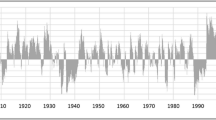Abstract
Characterizing wetland hydrology is key to assessing relative function over a range of wetland types. However, hydrologic data are often lacking. To address this lack of information, we categorized a set of 24 reference wetlands by hydrogeomorphic (HGM) subclass from 1993 to 1995, installed monitoring wells and piezometers, and assessed local water-table levels, pH, and specific conductance by month. Four HGM wetland subclasses were common to central Pennsylvania (riparian depression (n=8), slope (n=7), mainstem floodplain (n=5), and headwater floodplain (n=4)) and formed the basis for our analysis. Median depth to water in the wells differed by HGM subclass. Riparian depressions had the shallowest depth to water (−8 cm) and headwater floodplain wetlands the greatest (−70 cm). Comparisons of the percent occurrence of a piezometric head (from comparisons between paired piezometer and slotted wells) indicated that riparian depressions and slopes had significant ground-water inputs (47 and 48%, respectively), whereas the mainstem floodplain (31%) and headwater floodplain wetlands (23%) were more surface-water-driven systems. Water occurred within the root zone (30 cm) most often for riparian depressions (80% of observations), intermediate for slopes (48%), and least for mainstem floodplains (17%) and headwater floodplains (6%). Headwater floodplain wetlands were never inundated by overbank flow during this study but instead received water from snowmelt and overland flow after rain events. Mainstem floodplain wetlands were inundated by floods during major storm events. The upper 30 cm of soil (i.e., the root zone of plants) was almost continually saturated in riparian depressions, but rarely for both floodplain systems. Slope wetlands were intermediate between riparian depressions and floodplain systems in the amount of time water was present within 30 cm of the ground surface. Riparian depressions and slopes had lower pH than floodplain systems, and pH did not vary significantly by month for any HGM subclass. Floodplain systems (both headwater and mainstem) had greater values of specific conductance than either riparian depressions or slopes; riparian depressions were the only HGM subclass to show seasonality in specific conductance. Factors other than HGM subclass that may have influenced the hydrologic pattern and water quality parameters included bedrock geology, disturbance levels, and watershed attributes.
Similar content being viewed by others
Literature Cited
Babb, J. S., C. A. Cole, R. P. Brocks, and A. W. Rose. 1997. Hydrogeomorphology, watershed geology, and water quality of wetlands in central Pennsylvania. Journal of the Pennsylvania Academy of Science 71: In press.
Bishel-Machung, L. A., R. P. Brooks, S. S. Yates, and K. L. Hoover. 1996. Soil properties of reference wetlands and wetland creation projects in Pennsylvania. Wetlands 16:532–541.
Brinson, M. M. 1993a. Changes in the functioning of wetlands along environmental gradients. Wetlands 13:65–74.
Brinson, M. M. 1993b. A hydrogeomorphic classification for wetlands. U.S. Army Corps of Engineers. Vicksburg, MS, USA. Wetlands Research Program Technical Report WRP-DE-4.
Brinson, M. M. and R. Rheinhardt. 1996. The role of reference wetlands in functional assessment and mitigation. Ecological Applications 6:69–76.
Brooks, R. P., C. A. Cole, D. H. Wardrop, L. Bishel-Machung, D. J. Prosser, D. A. Campbell, and M. T. Gaudette. 1996. Evaluating and implementing watershed approaches for protecting Pennsylvania’s wetlands. Environmental Resources Research Institute, Pennsylvania State University, University Park, PA, USA. Final Report, 1996. Volume I. Penn State Cooperative Wetlands Center Report Number 96-2.
Bushnell, K. 1989. Geology of Pennsylvania wetlands. p. 39–46In S. K. Majumdar, R. P. Brooks, F. J. Brenner, and R. W. Tiner (eds.) Wetlands Ecology and Conservation: Emphasis in Pennsylvania. The Pennsylvania Academy of Science, Easton, PA, USA.
Cole, G. A. 1979. Textbook of Limnology. The C.V. Mosby Co., St. Louis, MO, USA.
Doss, P. K. 1995. Physical-hydrogeologic processes in wetlands. Natural Areas Journal 15:216–226.
Hupp, C. R., M. D. Woodside, and T. M. Yanosky. 1993. Sediment and trace element trapping in a forested wetland, Chickahominy River, Virginia. Wetlands 13:95–104.
Kleiss, B. A. 1996. Sediment retention in a bottomland hardwood wetland in eastern Arkansas. Wetlands 16:321–333.
Minitab, Inc. 1995. Minitab reference manual. Release 10Xtra for Windows. Minitab, Inc., State College, PA, USA.
Minitab, Inc. 1996. Minitab user’s guide. Release 11 for Windows. Minitab, Inc., State College, PA, USA.
National Research Council. 1995. Wetlands. Characteristics and boundaries. National Academy Press, Washington, DC, USA.
Novitzki, R. P. 1989. Wetland hydrology. p. 47–64In S. K. Majumdar, R. P. Brooks, F. J. Brenner, and R. W. Tiner, Jr. (eds.) Wetlands Ecology and Conservation: Emphasis in Pennsylvania. Pennsylvania Academy of Science, Easton, PA, USA.
Price, M. 1996. Introducing Groundwater. 2nd Edition. Chapman & Hall, London, England.
Ransom, M. D. and N. E. Smeck. 1986. Water table characteristics and water chemistry of seasonally wet soils of southwestern Ohio. Soil Science Society of America Journal 50:1281–1290.
Smith, R. D. 1996. Composition, structure, and distribution of woody vegetation on the Cache River floodplain, Arkansas. Wetlands 16:264–278.
Smith, R. D., A. Ammann, C. Bartoldus, and M. M. Brinson. 1995. An approach for assessing wetland functions using hydrogeomorphic classification, reference wetlands, and functional indices. U.S. Army Corps of Engineers, Waterways Experiment Station, Vicksburg, MS, USA. Wetlands Research Program Technical Report WRP-DE-9.
Author information
Authors and Affiliations
Corresponding author
Rights and permissions
About this article
Cite this article
Cole, C.A., Brooks, R.P. & Wardrop, D.H. Wetland hydrology as a function of hydrogeomorphic (HGM) subclass. Wetlands 17, 456–467 (1997). https://doi.org/10.1007/BF03161511
Received:
Revised:
Accepted:
Issue Date:
DOI: https://doi.org/10.1007/BF03161511



